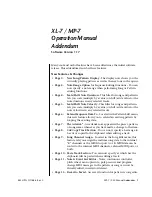
Pressure-Flow Study
Nexam Pro User Manual
91
This derivation depends on the hydrodynamic laws of flow through rigid tubes.
The urethra is both irregular and distensible.
Computed residual urine
The computed residual urine is calculated as the sum of the total infused
volume and the initial bladder filling minus the volume lost through leakage
and minus the voided volume. Note that the amount of urine produced by
diuresis during the test is not taken into account. It is assumed that the patient
has an empty bladder at the beginning of the test or that the bladder filling is
entered as the initial bladder filling before the start of the test.
A negative value for this parameter means that the volume lost by micturition
exceeds the total infused volume. This is explained if the volume produced by
diuresis during the investigation is taken into account.
Computed residual urine = Total bladder capacity
– Voided volume
= Init. Bladder Infused volume
– Volume lost through l Extra
infused volume
– Voided volume
Residual urine is the actual residual urine determined by catheterization of the
patient or with help of a bladder scanner.
Pdet compliance
Pdet compliance is the change in bladder volume for a change in detrusor
pressure.
It is defined as C = dV/dP, where dV is the volume increment and dP
is the change in pressure associated with this volume increment.
Compliance can be determined over a certain filling part of the investigation,
by placing two compliance markers. The first marker [A] should be placed just
after the start of the filling, the second marker [B] just before the end of the
filling. The software will calculate the compliance between the two markers.
Summary of Contents for Nexam Pro CIM
Page 1: ...Nexam Pro User Manual...
















































